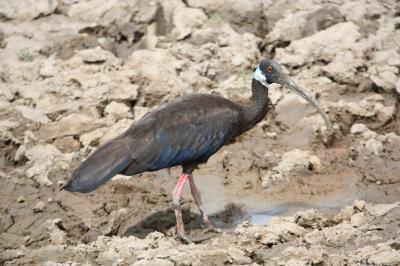Humans lend a hand to critically endangered waterbird
26 Jul 2009

A
white-shouldered ibis in Cambodia. Human impact on this critically endangered
bird can be beneficial rather than destructive, and could even save it from
extinction.
Credit: Hugh Wright
Published today in the peer-reviewed journal Animal Conservation, the study
by University of East Anglia conservation experts explores the exact reasons
behind the decline of the critically endangered white-shouldered ibis.
Funded by the Royal Society for the Protection of Birds (RSPB) and the Natural
Environment Research Council (NERC), the new study was carried out in Western
Siem Pang Important Bird Area (IBA), northern Cambodia, where 160-200 of the
birds survive – around half of the global population.
Working in partnership with BirdLife International, the researchers found that
the ibis prefer to forage in open and accessible sites with low vegetation and
bare soil. This is believed to be because it makes it easier to find prey, aids
take-off and landing, and improves detection of approaching danger.
Traditional small-scale farming by local communities is therefore crucial to
the ibis’ survival because grazing livestock and burning of the forest understorey
opens up these habitats making them suitable for the birds.
“Our findings show that this critically endangered species is largely dependent
on the local farmers for their survival,” said lead author Hugh Wright, of UEA’s
School of Environmental Sciences. “This is a fascinating outcome as we tend
to assume that human activity always has a negative impact on the natural world.”
Not all human influence is positive for the endangered ibis, however. Western
Siem Pang - currently an unprotected site – is under imminent threat from large-scale
development which would destroy the birds’ habitats entirely, along with the
local farming communities.
“The Forestry Administration in Cambodia is supportive of a proposal to make
the area a protected forest and we believe that this – along with the continuation
of local farming methods practiced for generation after generation – will be
crucial in saving this once common species from extinction,” added Hugh.
With fewer than 500 individuals remaining, mainly in Cambodia, the white-shouldered
ibis has undergone the most rapid decline of all South-East Asia’s large waterbirds
and is now the most threatened. Once common in Myanmar, Thailand, Laos, Cambodia,
Vietnam and Indonesia, the precise causes behind the bird’s continuing decline
have until now been poorly understood, which has hindered conservation efforts.
***
‘Dry season habitat use by critically endangered white-shouldered ibis in
northern Cambodia’ by H Wright (UEA), D Buckingham (RSPB) and P Dolman (UEA)
is published online on Monday July 27 2009 by Animal Conservation.
Contact: Simon Dunford
s.dunford@uea.ac.uk
University of East Anglia
Copyright © 2006-2009 birdpoints. All rights reserved.
 A
white-shouldered ibis in Cambodia. Human impact on this critically endangered
bird can be beneficial rather than destructive, and could even save it from
extinction.
A
white-shouldered ibis in Cambodia. Human impact on this critically endangered
bird can be beneficial rather than destructive, and could even save it from
extinction.